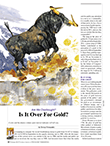LETTERS TO THE EDITOR
April 2012 Letters To The Editor
The editors of S&C invite readers to submit their opinions
and information on subjects relating to technical analysis and this magazine.
This column is our means of communication with our readers. Is there something
you would like to know more (or less) about? Tell us about it. Without a source
of new ideas and subjects coming from our readers, this magazine would not
exist.
Address your correspondence to: Editor, Stocks & Commodities,
4757 California Ave. SW, Seattle, WA 98116-4499, or E-mail to editor@traders.com.
All letters become the property of Technical Analysis, Inc. Letter-writers
must include their full name and address for verification. Letters may
be edited for length or clarity. The opinions expressed in this column do not
necessarily represent those of the magazine. —Editor
BACKTESTING WITH OUT-OF-SAMPLE DATA
Editor,
I have been developing an intermediate-term stock trading model, which captures weekly closes of stock prices (approximately 550) and major indexes from 12/31/1999 to 1/27/2012. My model has been optimized and backtested for the in-sample data from 12/31/1999 to 06/25/2010 with excellent results. The data from 6/25/2010 to 1/27/2012 has been forward-tested (out of sample) and has a return of 32.05% compared to a 24.81% return of the Dow Jones Industrial Average (dividends not included).
In order to determine the feasibility of my model and also to enhance my confidence in it, I would like to know: If I downloaded several additional stocks to my database from 2000 to present and run them against my rules, would the additional data be considered out-of-sample data?
Dominick Paoloni
Roselle, NJ
Looking at the definitions of in-sample and out-of-sample testing may help you determine whether testing on additional data would qualify as out-of-sample. When you run a system on the same historical data set that was used to develop the system, it is considered in-sample data. Out-of-sample testing is when you run the same system on data that it has not encountered before in the same market and time frame.—Editor
STRATEGY-HOSTING PROVIDERS
Editor,
I am a subscriber and have been for a few years.
I develop and test my own strategies on TradeStation part-time, but as I still work in my day job, I need to find a good strategy-hosting provider to host my strategies on their servers, ensuring uninterrupted Internet connections and so on, as well as the relevant development from EasyLanguage code and testing.
Do you have a list of providers for this type of service, or can you advise the best way to locate these types of providers?
Rupert Faulkner
Several providers are available to host your trading strategy. While we are unable to recommend specific products or services, we suggest typing “trading strategy hosting providers” into an Internet search engine and some providers will be listed.
TradeStation has a new beta service at TradeStation.com called Strategy Network, so we checked with TradeStation but it does not host autotrading systems or user-designed strategies.
You might also check with your broker, since several brokerages offer the ability to system-trade via a trading platform. See also our Readers’ Choice Awards in our Bonus Issue for the categories of Institutional Platforms and Professional Platforms for trading platforms.
Another possible avenue is Collective2.com, which hosts collected systems that interface with select brokerages.
Finally, see https://news.stockbrokers.com/online-brokers-autotrading for a list of brokerages that will autotrade a system, but be sure to verify that it’s up-to-date.—Editor
S&P EMINI HISTORICAL DATA SOURCE
Editor,
I’m looking for S&P emini intraday globex information for 2007–10; OHLC would be great, 15-minute tick charts would be fabulous (or anything in between). Can you recommend a source for this information?
Robert Jackson
Most data providers can offer this information. See our most recent Readers’ Choice Awards for a list of data providers, or visit the Traders’ Resource feature at our website. www.traders.com, for a list of data vendors.—Editor
IS IT OVER FOR GOLD?
 Editor,
Editor,
I have been a technical analyst for 50 years, but I am grateful the fundamentals are overpoweringly bullish in this market, with a near total absence of public participation and massive inflation worldwide. If you thought the public was a significant participant in September 2011, you should review the COT (Commitments Of Traders) allocations for the year ending then; no month showed lower participation by small traders on average, basis the three-year extremes, and even the raw position showed no particular interest by that group. Even today (as of this writing in January 2012), it is hard to find anyone interested in establishing a metals position, nor is it likely while MF Global remains of interest in the press.
As much as I would like to believe otherwise, I cannot bring myself to accept the reliability of technical factors in a market controlled by the massive presence of the too-big-to-fail bullion banks and their great short positions. They know how to create any technical picture they want.
As for comparing the runup last summer (2011) to that at the climax of the 1970s bull run: they were equivalent only in points. Every other aspect of those two moves was completely different; the 1980 atmosphere was a much closer parallel to the real estate bubble during the two years before the 2008 smash. I particularly recall the department stores being heavily backordered in everything made of gold and silver, the relative share of the cost of which was artisan labor notwithstanding.
L. Grapentine
Author Teresa Fernandez replies:
Thanks for your thoughtful comments and for reading my February 2012 article in S&C, “Is It Over For Gold?”
As you correctly point out, technical analysis is not the answer to all investment decisions. I expect professional investors to do more than just read charts and find event patterns. However, the majority of investors, of which my readers are, simply do not have the time or inclination to immerse themselves in the intricacies of the gold market. I like to encourage people to invest in gold when it is appropriate to do so. But at the same time, I don’t want to overwhelm them with too many things to do in order to follow gold. After all, they have jobs to go to, families to spend time with — in other words, lives to lead. More than anything, I want to encourage ordinary investors to do their own work and avoid being carried away by the media, since as a general rule, they are wrong most of the time.
The technical analysis I present teaches people how to catch a big part of a big move in gold, rather than to do what professionals are able to do, which is catch almost the entire trip of every major move. Consequently, investors who follow the discipline I present can make money on gold, though not the fortunes that professionals do. But if they are able to make money in gold, they will be in the market, and the more people in the market, the less it can be controlled. If I can convince the ordinary investor to invest in gold on a regular basis, I will have made some contribution toward lessening the control that big players have in the gold market. This ideal situation is a long way away, but we have to start somewhere.
KONDRATIEFF WAVE
 Editor,
Editor,
I write once again to commend Koos van der Merwe for his superb article in the November 2008 issue of Stocks & Commodities (“My Kondratieff Wave”). His suggestion that “we could consider accumulating shares in 2010” has proven to be spot-on.
Does Merwe think there could be a major pullback in 2012 that investors could sidestep, or should they remain fully invested through 2016?
RW Dusing
Author Koos van der Merwe replies:
Of course the market will correct, but it is not likely to be anything serious, just further opportunities to accumulate. The market is projected to continue rising until 2016. The Presidential cycle is tying in with the K-wave.
Originally published in the April 2012 issue of Technical Analysis of Stocks & Commodities magazine. All rights reserved. © Copyright 2012, Technical Analysis, Inc.
Return to
Contents
 Editor,
Editor, Editor,
Editor,